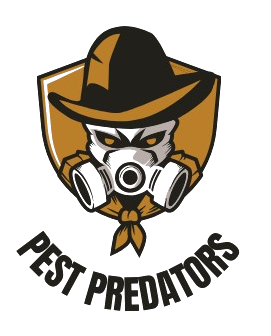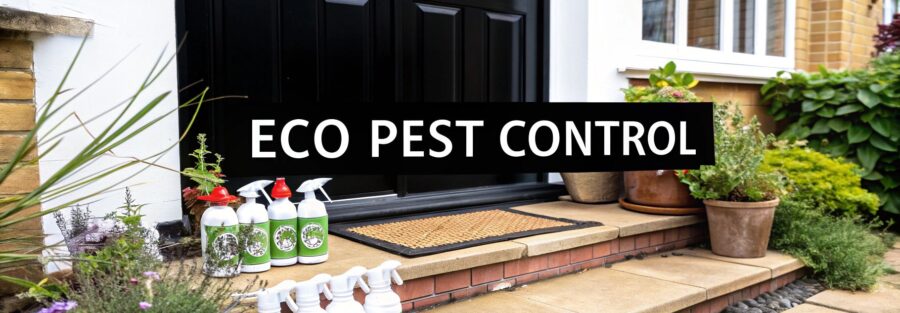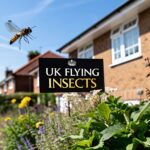That sinking feeling when you spot the first sign of pests is universal. But before you frantically search for "pest control near me," taking a moment to breathe and assess the situation can make a huge difference. A calm, methodical approach will lead to a faster, more effective, and often cheaper solution in the long run.
Your First Move When You Suspect Pests

Panic is a natural reaction, but it's not a productive one. The very first steps you take will set the tone for getting rid of the problem successfully. Acting deliberately gives you the crucial information you'll need when you eventually call in the professionals.
Identify and Document Everything
Before you touch a thing, become a detective. Your first job is to try and identify the pest and document every bit of evidence you can find. Grab your phone and take clear photos of droppings, gnaw marks on wood, damaged fabrics, nesting materials, or even the pests themselves if you can get a shot. This visual evidence is worth its weight in gold to a technician.
Your notes should include:
- Location: Where exactly did you find the signs? Be precise—under the kitchen sink, in the corner of a specific cupboard, or along the skirting board behind the sofa.
- Time of Day: Make a note of when you're seeing activity. Rodents are often most active at night, whereas other pests might be more obvious during the day.
- Frequency: Was this a one-off sighting, or is it happening every day? This helps us gauge the scale of the problem.
This kind of detailed information is far more helpful than a vague call saying, "I think I have mice." It helps a pest control expert build a proper picture of the situation before they even arrive. If the infestation seems severe and you need help right away, it’s worth understanding what qualifies as a pest control emergency.
A detailed log of pest sightings transforms your initial call from a vague cry for help into a productive consultation. It allows for a much more accurate initial assessment and quote.
The UK pest control industry is growing, which means you have more choice than ever. There are now around 854 pest control companies operating across the country, a 6.4% increase from last year. This boom makes your initial preparation even more vital for finding the right expert for the job. Having your evidence organised and ready ensures you can properly vet this growing number of providers and choose a company that truly knows its stuff.
How to Vet Local Pest Control Companies
So, you’ve done your “pest control near me” search and have a shortlist of local companies. Brilliant. Now comes the important part: digging a little deeper to separate the true professionals from the rest. A slick website and a low price don't always tell the whole story. Your goal is to find someone effective, reliable, and genuinely committed to eco-friendly practices.
The first thing I always look for is a sign of professional accreditation. Here in the UK, the gold standard is membership with the British Pest Control Association (BPCA). This isn't just a fancy logo for their van; it's a guarantee they follow a strict code of conduct, carry the right insurance, and employ properly trained technicians. It’s a massive tick in the box.
Beyond the Basics: Check Their Credentials
Simply having a business listing isn’t enough. Any reputable company will be upfront about their qualifications and insurance. Don't be afraid to ask for proof. This is a non-negotiable step—it protects you, your home, and ensures you're dealing with a legitimate business, not a fly-by-night operator.
It's also wise to be aware of the common red flags. You can apply general tips to avoid home service scams to spot potential issues early on, as many of the same warning signs apply across all home services.

Decode Reviews and Ask the Right Questions
Online reviews offer fantastic insights, but you have to learn to read between the lines. A vague, one-line "great service" review is far less helpful than a detailed story about how a technician solved a tricky rodent problem using clever, long-term methods. Look for reviews that mention the specific problem, the solution offered, and the technician's professionalism.
Don't just ask, "How much does it cost?" Instead, ask, "What’s your approach?" A company that immediately talks about Integrated Pest Management (IPM) is showing a commitment to sustainable, long-term solutions, not just quick chemical fixes. This is a key differentiator.
The UK pest control market is a big one, valued at around £1.25 billion and still growing. While that means more choice for you, it also means you have to be more discerning.
A company's guarantee can also be very telling. A strong, clear guarantee shows they are confident in their work and stand behind their results. To get a feel for what comprehensive, professional offerings look like, take a look at the different types of pest control services available from an established provider.
Comparing Local Pest Control Services
To make the process easier, use a simple checklist to compare the companies on your shortlist. It helps you stay organised and make an objective decision based on what really matters.
| Evaluation Criteria | Company A | Company B | Company C |
|---|---|---|---|
| BPCA Member? | |||
| Fully Insured? | |||
| Positive, Detailed Reviews? | |||
| Transparent About Methods (IPM)? | |||
| Offers a Clear Guarantee? | |||
| Professional and Helpful on the Phone? | |||
| Total Score |
By the end of this, you’ll have a much clearer picture of who you’re dealing with. Taking a bit of time to do this research upfront almost always saves you a lot of hassle—and money—down the line.
Understanding Modern Eco-Friendly Treatments

Let's be clear: modern pest control has moved far beyond the old image of a technician turning up to douse everything in harsh chemicals. Today’s forward-thinking approach is smarter, more strategic, and far kinder to the environment. It’s all about getting to the root of the problem for a lasting solution, not just a temporary fix.
The heart of this strategy is Integrated Pest Management (IPM). Think of it as a bit of detective work. Instead of just reacting to pests, an IPM professional focuses on understanding their behaviour, their life cycles, and what’s attracting them to your home in the first place. This might mean spending more time sealing entry points or advising on moisture control than ever reaching for a spray bottle.
This isn’t just a niche idea; it’s a major shift across the industry. For example, the latest trends in fly control show a clear move away from purely chemical treatments towards clever IPM approaches. This is fantastic news for anyone searching for "pest control near me" who wants a solution that's both effective and responsible.
What Does This Look Like in Practice?
So, what does this actually mean when a technician visits your home? Instead of a one-size-fits-all chemical blast, you get a tailored plan that uses several tactics working together for maximum impact.
Here are a few real-world examples:
- Heat Treatments: For pests like bedbugs, we can use specialised equipment to raise the temperature in a room to a lethal level. It’s a brilliant way to eliminate all life stages—eggs, larvae, and adults—without a single chemical.
- Physical Barriers: Instead of relying solely on rodenticides, a huge part of modern rodent control is proofing. This means physically blocking their routes with wire wool, mesh, and even cement so they simply can’t get back in.
- Targeted Baits and Gels: When products are needed, they are used with absolute precision. For cockroaches, we can place tiny gel baits in the cracks and crevices where they hide, targeting them directly while keeping the product safely away from children and pets.
The real goal of modern eco-friendly pest control isn’t just to remove the current infestation; it’s to make your home less attractive to pests in the future. It’s a long-term strategy for total peace of mind.
By understanding these methods, you can ask better questions and know exactly what to look for in a quality service. For a deeper dive into how these methods work, check out our detailed guide on eco-friendly pest control. It’s all about choosing a service that solves today's problem and prevents tomorrow's.
What to Ask When You Make the Call
You’ve done your homework, checked their credentials, and narrowed down your search for local pest control to a handful of solid contenders. Now for the crucial part: picking up the phone.
This first call is more than just a price check. It’s your chance to really understand who you’re dealing with. A vague or rushed answer to any of your questions should be a major red flag. A truly professional company will be happy to walk you through their process.
Discussing the Treatment Process
When you call, don't just say "I have ants". Start by clearly explaining the signs of the infestation you've found and documented. From there, the conversation should naturally move to their proposed strategy.
A good technician won't just throw a number at you. They’ll listen, ask questions, and then explain the why behind their approach.
Here are a few key things to get clear on:
- Do you offer a free initial survey? A proper assessment is the foundation of any effective treatment.
- What specific eco-friendly methods do you propose for my situation? This shows if they have a one-size-fits-all approach or a tailored one.
- How many visits are included in the quote? And just as important: what happens if the problem comes back?
This conversation is all about figuring out if they're offering a genuine, long-term solution or just a quick, temporary fix. It’s also the perfect time to ask about their guarantees.
Don’t be shy about asking direct questions about safety, especially if you have children or pets running around. A reputable provider will have no problem explaining which products they use, any necessary precautions, and whether you’ll need to leave the property during treatment.
Finally, before you agree to anything, make sure you get it all in writing. A professional service will always provide a detailed quote that outlines the full scope of work, including the costs for every visit and all materials.
This isn't just about avoiding nasty surprises on the final bill; it's about making sure everyone is on the same page from the get-go. Clear communication right from this first call sets the tone for a successful, stress-free treatment.
Preparing Your Home for a Pest Control Visit

A successful pest treatment isn’t just down to the technician; it's a team effort. Taking a bit of time to prep your home beforehand can make a massive difference to the results and even speed up the whole process.
Think of it as clearing the way for the expert to do their best work. Good preparation allows them to get right to the key areas where pests live and breed, which is crucial for effective treatment.
For example, if you're dealing with cockroaches, clearing out the cupboards under your kitchen sink is vital. This gives direct access to the pipework and dark corners they love, ensuring treatments are applied exactly where they're needed most.
Creating a Clear Path for Treatment
A clutter-free environment is your number one priority. Our technicians need unobstructed access to skirting boards, wall junctions, and behind furniture to be truly effective. A bit of prep goes a long way.
Here’s a quick checklist to get your home ready:
- Move furniture away from walls: Try to pull sofas, beds, and cabinets about a foot away from the walls. This creates a clear channel for treatment.
- Clear floor spaces: Pick up any toys, clothes, and other items, especially in the rooms being treated.
- Empty kitchen cupboards: For cockroach or ant treatments, it’s best to remove all food, plates, and utensils.
- Secure pets: For their safety and to prevent any interference, it’s best to arrange for pets to be in another room or out of the house entirely during the visit.
Remember, the goal is to make it as easy as possible for the treatment to reach every single potential hiding spot. A little effort from you makes a huge difference to the outcome.
Beyond professional treatments, taking proactive steps like properly installing bug screens can also significantly reduce future pest entry points. Following these simple steps ensures the service you’ve booked is as effective as it possibly can be.
Answering Your Top Pest Control Questions
When you're searching for "pest control near me," you’re bound to have a few questions. It’s completely normal to want some clear answers before you let a technician into your home. We've pulled together the most common queries we get from UK homeowners to help you make a confident, informed choice.
Figuring out the cost is usually the first step, and it can feel a bit unpredictable at first.
How Much Should I Expect to Pay for Pest Control in the UK?
There’s really no one-size-fits-all price tag for pest control. The cost is tied directly to the type of pest, how bad the infestation has become, and the size of your property. For example, a straightforward wasp nest removal might set you back between £60-£100. On the other hand, a more complex, multi-visit rodent treatment could easily range from £200-£400+.
It’s always a good idea to get a few quotes to compare, but be cautious of any price that seems too good to be true. An unusually low quote can sometimes signal an incomplete job or nasty hidden fees down the line. A proper, professional quote will always be clear about what’s included, especially when it comes to follow-up visits.
Are Eco-Friendly Pest Control Methods Actually Effective?
Absolutely, yes. Modern eco-friendly methods are incredibly effective, especially when they’re part of an Integrated Pest Management (IPM) strategy. It's a smarter way of doing things. Instead of just spraying chemicals and hoping for the best, IPM focuses on tackling the root cause of the problem—things like sealing up entry points or removing food sources.
This approach doesn't just work; it creates lasting, sustainable solutions. You get better results, and we lessen our impact on the environment. It's a win-win.
The real strength of eco-friendly treatments is their strategic, long-term approach. You’re not just getting a temporary chemical fix. You're getting a solution that addresses the why behind the pest problem, which is the key to preventing it from happening again.
How Quickly Will I See Results from a Treatment?
The timeline really depends on the pest we're dealing with. A simple wasp nest treatment offers almost immediate relief—you'll see a difference within hours. However, more stubborn problems like rodents, cockroaches, or bedbugs require a more patient, strategic approach that unfolds over several weeks.
You should always notice a significant drop in pest activity right after the first visit. Full control is usually achieved once all the follow-up appointments are done, which ensures we’ve disrupted the entire pest lifecycle from egg to adult.
Do I Need to Leave My Home During the Treatment?
This is a big concern, particularly for families with children and pets. The good news is, for many modern and targeted eco-friendly methods like gels or bait stations, you can safely stay at home while we work.
In some cases, like with certain spray treatments or fumigation, you and your pets might need to pop out for a few hours. Your pest control professional will always give you clear, specific instructions well in advance so you know exactly what to expect.
At Pest Predators Limited, we believe in providing clear answers and effective, science-backed solutions for your home. Learn more about our eco-friendly pest control services today!


